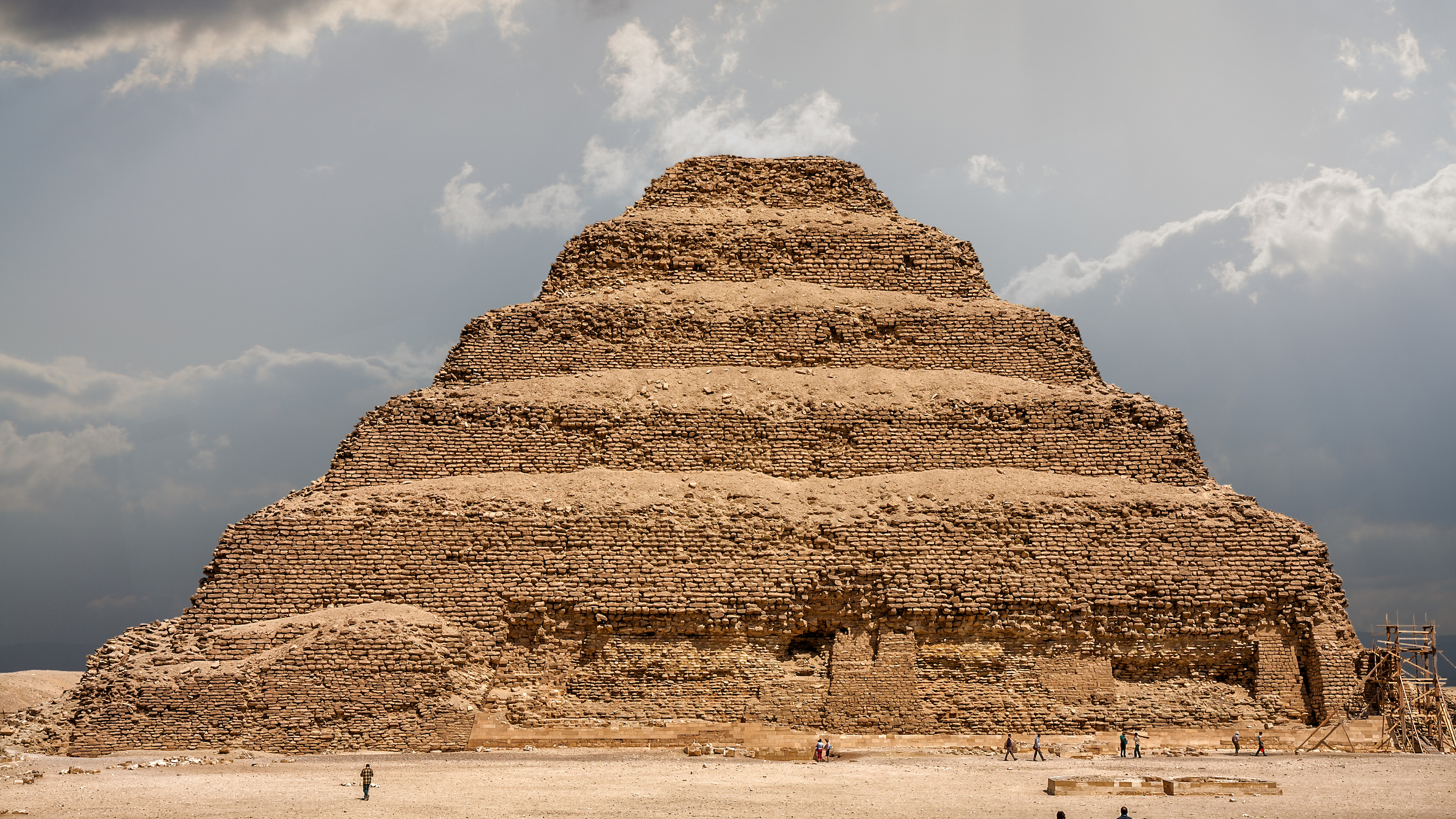
Who built the Egyptian pyramids?
It wasn't aliens or even people from the 'lost' city of Atlantis.

Egypt's pyramids are an archaeological marvel, rising high above the desert sands and visible for miles on end. Building these pyramids was undoubtedly a mammoth task, so who were the individuals that pulled it off?
There are many theories about who built Egypt's pyramids, including large teams of enslaved Jewish people and wilder ideas, such as inhabitants of the 'lost' city of Atlantis or even aliens.
None of these theories, however, have evidence to back them up.
Related: How were the Egyptian pyramids built?
The pyramids could not have been constructed by Jewish slaves, as no archaeological remains that can be directly linked to the Jewish people have been found in Egypt that date back to 4,500 years ago, when the Giza pyramids were built, archaeological research has revealed. Additionally the story told in the Hebrew Bible about Jews being slaves in Egypt refers to a city named "Ramesses." A city named pi-Ramesses was founded during the 19th dynasty (about 1295-1186 B.C.) and was named after Ramesses II, who ruled 1279–1213 BC. This city was constructed after the era of pyramid construction had ended in Egypt.
"We have no clue, not even a single word, about early Israelites in Egypt: neither in monumental inscriptions on walls of temples, nor in tomb inscriptions, nor in papyri," wrote archaeologists Israel Finkelstein and Neil Asher Silberman in their book "The Bible Unearthed: Archaeology's New Vision of Ancient Israel and the Origin of its Sacred Texts" (The Free Press, 2001).
What's more, no archaeological evidence has ever been found for the lost city of Atlantis in any time period, and many scholars believe that the story is fictional. As for aliens, well, that idea is out of this world.
Sign up for the Live Science daily newsletter now
Get the world’s most fascinating discoveries delivered straight to your inbox.
In fact, all the evidence shows that the ancient Egyptians built the pyramids, Egyptologists say. But how the pyramid builders lived, how they were compensated and how they were treated is a mystery that researchers are still investigating.
The pyramids and their builders
Egypt has more than 100 ancient pyramids, but its most famous include the first step pyramid, built during the reign of the pharaoh Djoser (about 2630-2611 B.C.), and the first true pyramid — one that has smooth sides — built under the rule of pharaoh Snefru (about 2575-2551 B.C.), Mark Lehner wrote in his book, "The Complete Pyramids: Solving the Ancient Mysteries" (Thames & Hudson, 2008). The Great Pyramid was constructed at Giza during the reign of pharaoh Khufu (about 2551-2528 B.C.), and two of his successors, Khafre (about 2520-2494 B.C.) and Menkaure (about 2490-2472 B.C.), also had pyramids built at Giza.
Pharaohs gradually stopped building pyramids during the New Kingdom (1550-1070 B.C.), choosing instead to be buried in the Valley of the Kings, which is located about 300 miles (483 km) south of Giza, Lehner noted in his book. Over the past few decades, archaeologists have found new pieces of evidence that provide clues as to who the pyramid builders were and how they lived.

Surviving written records, including papyri discovered in 2013 at Wadi al-Jarf on Egypt's Red Sea coast, indicate that large groups of workers — sometimes translated as "gangs" — helped bring material to Giza. The papyri found at Wadi al-Jarf tell of a group of 200 men headed by an inspector named Merer. The group of workers transported limestone by boat along the Nile River a distance of about 11 miles (18 kilometers) from Tura to the Great Pyramid, where the stone was used to build the outer casing of the monument.
In the past, Egyptologists had theorized that the pyramid builders were largely made up of seasonal agricultural workers who had reached a point in the year in which there was little agricultural work to be done. However, it remains to be seen whether this is actually true. The papyri detailing the pyramid's histories are still in the process of being deciphered and analyzed, but the results indicate that the gang led by Merer did far more than help with pyramid construction. These workers appear to have travelled over much of Egypt, possibly as far as the Sinai Desert, carrying out various construction projects and tasks that had been assigned to them. This raises the question of whether they were part of a more permanent professional force rather than a group of seasonal agricultural workers who would return to their fields.
According to the papyri, the workers were given a diet that included dates, vegetables, poultry and meat, said Pierre Tallet, an Egyptology professor at Paris-Sorbonne University who is deciphering the papyri and is co-leader of the team that found them. In addition to the healthy diet, the papyri describes members of the work team regularly getting textiles that were "probably considered as a kind of money at that time," Tallet told Live Science.
Additionally, officials in high-ranking positions who were involved in pyramid construction "might have received grants of land," said Mark Lehner, director of Ancient Egypt Research Associates (AERA), a research institute based in Massachusetts. Historical records show that at times in Egypt's history, land grants were given out to officials. However, it's unknown whether land grants were also given to officials involved with pyramid construction.
Lehner's team has been excavating a town at Giza that was lived in and frequented by some of the workers who were constructing the pyramid of Menkaure. So far, the archaeologists have found evidence that this town's ancient inhabitants used to bake large amounts of bread, slaughter thousands of animals and brew copious amounts of beer. Based on the animal bones found at the site, and considering the nutritional needs of the workers, archaeologists estimate that about 4,000 lbs. (1,800 kilograms) of animals — including cattle, sheep and goats — were slaughtered every day, on average, to feed the workers.
The remains of workers buried in graves near the pyramids show that the workers had healed bones that were set properly — suggesting that they had access to the medical care that was available at the time. The rich diet of the pyramid builders, combined with the evidence for medical care and receiving textiles as a form of payment, has led Egyptologists to generally agree that the workers were not enslaved people.
But this doesn't mean all of the workers got equal accommodations. AERA's excavations show that some of the higher-ranking officials lived in large houses and had the choicest cuts of meat. In contrast, Lehner suspects that the lower-ranking workers likely slept in simple dwellings or "lean-tos" at the pyramids themselves.
Originally published on Live Science.

Owen Jarus is a regular contributor to Live Science who writes about archaeology and humans' past. He has also written for The Independent (UK), The Canadian Press (CP) and The Associated Press (AP), among others. Owen has a bachelor of arts degree from the University of Toronto and a journalism degree from Ryerson University.









